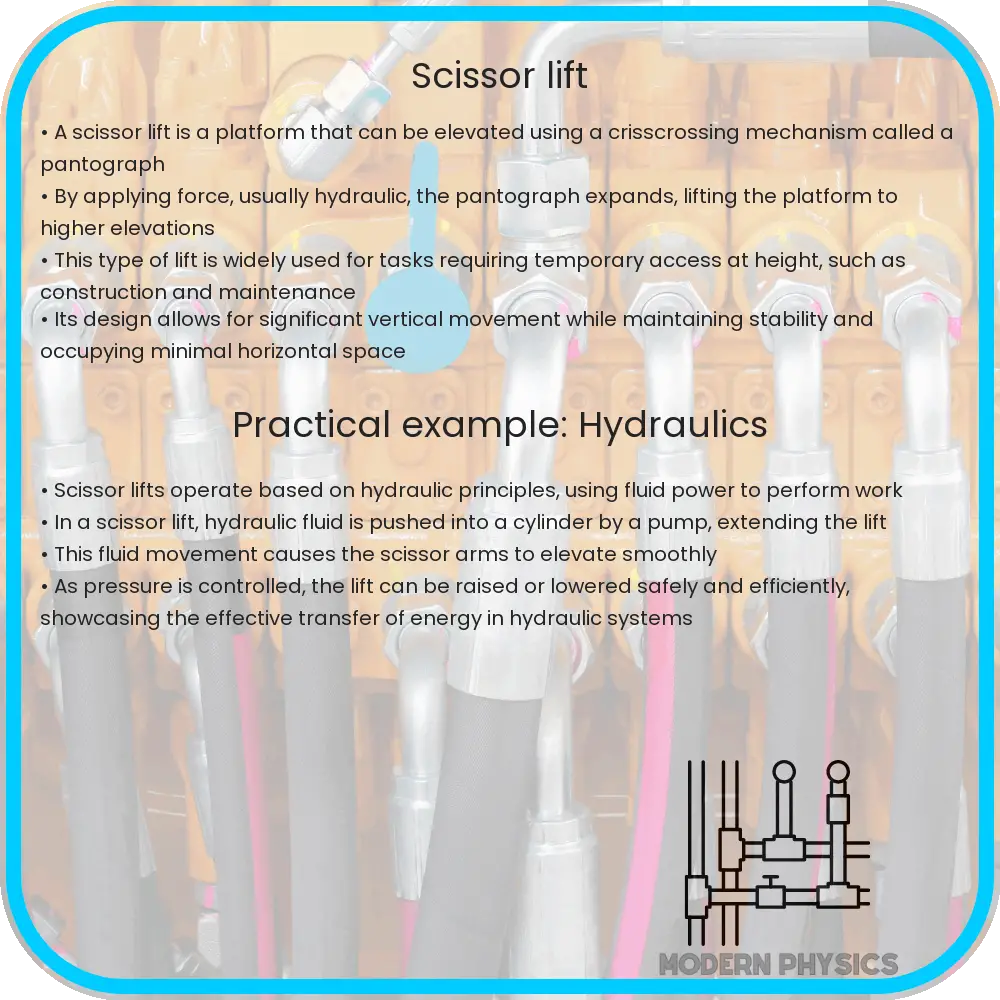Explore the essentials of scissor lifts, covering stability, load capacity, and mechanics, with best practices and technological advancements.

Understanding the Fundamentals of Scissor Lifts
Scissor lifts are a prevalent type of mobile aerial work platform used in a variety of industries for tasks such as construction, maintenance, and warehousing. These lifts offer a stable and secure platform for workers to perform tasks at elevated heights. In this article, we delve into the key aspects of scissor lifts, focusing on their stability, load capacity, and underlying mechanics.
Stability of Scissor Lifts
The stability of a scissor lift is crucial for the safety of the operators. Stability is primarily influenced by the design of the lift, including the base width, the scissor mechanism, and the center of gravity. The wider the base, the more stable the platform. Furthermore, the scissor mechanism, consisting of cross-bracing supports, contributes significantly to maintaining stability even when the platform is extended to its maximum height. Manufacturers often implement safety features like tilt sensors and stabilizer legs to enhance stability in uneven terrains.
Load Capacity
Load capacity refers to the maximum weight a scissor lift can safely carry. It varies depending on the model and size of the lift. This capacity includes not just the weight of the materials and tools but also the weight of the personnel on the platform. Overloading a scissor lift can lead to mechanical failure or tipping, which is why understanding and adhering to the specified load capacity is paramount for safety.
Mechanics of Scissor Lifts
The central mechanism of a scissor lift is the eponymous ‘scissor’ structure – a series of linked, folding supports in a crisscross ‘X’ pattern. This structure elongates and compresses to raise or lower the platform. The movement is typically powered by hydraulic, pneumatic, or mechanical means. Hydraulic scissor lifts use pressurized fluid to move the arms of the lift. The formula for the hydraulic force is F = P x A, where F is the force, P is the pressure, and A is the area of the piston.
The stability and safety of scissor lifts are enhanced by various mechanisms. For instance, hydraulic systems might include valves to control the speed of descent in case of a pressure loss. Mechanical lifts often use a lead screw or rack-and-pinion system, which offers precise control over the movement of the platform.
Understanding these fundamental aspects of scissor lifts is crucial for their safe and efficient operation. In the next section, we will explore best practices for operating and maintaining scissor lifts, as well as the latest technological advancements in this field.
Best Practices for Operating Scissor Lifts
Safe operation of scissor lifts is paramount. Operators should receive proper training on the specific model they are using. This includes understanding the control mechanisms, weight limits, and safety features. Regular safety checks are essential, including inspecting the lift mechanism, platform, guardrails, and emergency controls before use. It is also crucial to be aware of the surroundings, avoiding overhead obstacles and ensuring the ground is stable enough to support the lift.
Maintenance of Scissor Lifts
Regular maintenance is key to the longevity and safety of scissor lifts. This includes routine inspections, lubrication of moving parts, and checks for hydraulic fluid leaks. Any signs of wear or damage should be addressed immediately to prevent accidents. It’s also important to keep records of maintenance activities as part of a comprehensive safety program.
Technological Advancements in Scissor Lifts
Advancements in technology have led to significant improvements in scissor lift design and functionality. Modern lifts often include advanced safety features like automatic braking systems, overload sensors, and real-time angle indicators. Additionally, electric and hybrid models are becoming more popular due to their environmental benefits and suitability for indoor use due to lower emissions and noise levels.
Conclusion
Scissor lifts are indispensable tools in various industries, providing a safe and efficient way to work at heights. Understanding their mechanics, load capacities, and stability is essential for safe operation. Regular maintenance and adherence to best practices ensure the longevity and reliability of these machines. Technological advancements continue to enhance the safety and efficiency of scissor lifts, making them even more versatile and user-friendly. By adhering to these guidelines, users can maximize the benefits of scissor lifts while maintaining a safe working environment.
